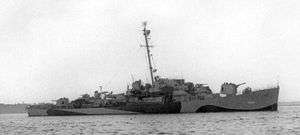USS Oberrender
 An undated wartime image of USS Oberrender, exact date and location unknown. | |
| History | |
|---|---|
| Name: | Oberrender |
| Namesake: | Thomas Olin Oberrender, Jr. |
| Builder: | Consolidated Steel Corporation, Orange, Texas |
| Laid down: | 8 November 1943 |
| Launched: | 18 January 1944 |
| Commissioned: | 11 May 1944 |
| Decommissioned: | 11 July 1945 |
| Struck: | 25 July 1945 |
| Identification: | DE-344 |
| Fate: | Sunk as a target on 6 November 1945 |
| General characteristics | |
| Class and type: | John C. Butler-class destroyer escort |
| Displacement: | 1,350 tons |
| Length: | 306 ft (93 m) |
| Beam: | 36 ft 8 in (11.18 m) |
| Draft: | 9 ft 5 in (2.87 m) |
| Propulsion: | 2 boilers, 2 geared turbine engines, 12,000 shp (8,900 kW); 2 propellers |
| Speed: | 24 knots (44 km/h; 28 mph) |
| Range: | 6,000 nmi (11,000 km; 6,900 mi) at 12 kn (22 km/h; 14 mph) |
| Complement: | 14 officers and 201 enlisted men |
| Armament: |
|
USS Oberrender (DE-344) was a John C. Butler-class destroyer escort built for the United States Navy during World War II. Named for Lieutenant Commander Thomas Olin Oberrender, Jr., the engineering officer aboard the light cruiser USS Juneau who was killed when the ship was torpedoed and subsequently sunk during action in the Solomon Islands.
Oberrender's keel was laid down by the Consolidated Steel Corporation of Orange, Texas on 8 November 1943. The ship was launched on 18 January 1944; sponsored by Mrs. Thomas Olin Oberrender, Jr., widow of Lieutenant Commander Oberrender; and commissioned on 11 May 1944 with Lieutenant Commander Samuel Spencer in command. Following commissioning and fitting out, Oberrender sailed 28 May 1944 for Bermuda, where she conducted shakedown until early July. She steamed via Norfolk and Aruba for the Panama Canal, which she transitted on 1 August.
History
Assigned to protect convoys plying between Pearl Harbor and Eniwetok, the new destroyer escort completed two runs to the Marshall Islands by 30 September. After a stop at Manus in the Admiralty Islands, Oberrender escorted Rear Admiral Thomas Sprague’s escort carriers to the Philippines for the invasion of Leyte. A brief trip to Morotai, however, caused her to miss the Battle of Leyte Gulf. The ship was in Seeadler Harbor, Manus Island, on 10 November 1944 only 1,100 yards (1,000 m) from the ammunition ship USS Mount Hood when Mount Hood blew up. Damage incurred from flying debris and exploding ammunition forced Oberrender to remain at Manus for the rest of November. December 1944 found her back in fighting trim, and for three more months she conducted escort and patrol duties in the Netherlands East Indies and Philippines areas.
As American forces pushed closer to the Japanese Home Islands, Oberrender moved along in the van. Through April and into May 1945, the Battle of Okinawa was the focus of attention. There, on 9 May 1945, a Japanese kamikaze crashed into Oberrender on her starboard side. A bomb carried by the plane penetrated the forward fire room, where it exploded and caused extensive heavy damage. Twenty-four sailors were killed, wounded, or listed as missing as a result of the blast. Towed to Kerama Retto, Oberrender was beyond repair. She was decommissioned on 11 July 1945 and was struck from the Naval Vessel Register on 25 July 1945. Stripped of all worthwhile equipment, her hulk was sunk by gunfire on 6 November 1945.
Honors
Oberrender earned 3 battle stars for World War II service.
Awards, citations and campaign ribbons
| Combat Action Ribbon (retroactive) | |
| American Campaign Medal | |
| Asiatic-Pacific Campaign Medal (with three battle stars) | |
| World War II Victory Medal |
See also
- See List of U.S. Navy losses in World War II for other Navy ships lost in World War II.
References
_after_the_explosion_of_USS_Mount_Hood_(AE-11)_at_Seeadler_Harbor_on_10_November_1944.jpg)
- This article incorporates text from the public domain Dictionary of American Naval Fighting Ships. The entry can be found here.
- "Oberrender". Dictionary of American Naval Fighting Ships. Retrieved 15 March 2007.
- "USS Oberrender (DE-344)". Destroyer Escort Photo Archive. Retrieved 15 March 2007.